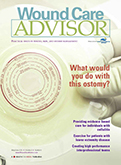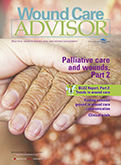Get the ‘SKINNI’ on reducing pressure ulcers
Like many hospitals, Houston Methodist San Jacinto Hospital uses national benchmarks such as the National Database of Nursing Quality Indicators (NDNQI®) to measure quality outcomes. Based on benchmark reports that showed an increased trend of pressure ulcers in critically ill patients in our hospital, the clinical nurses in our Critical Care Shared Governance Unit-Based Council (CCSGUBC) identified an improvement opportunity.
A collaborative approach to wound care and lymphedema therapy: Part 1
By Erin Fazzari, MPT, CLT, CWS, DWC Have you seen legs like those shown in the images below in your practice? These images show lymphedema and venous stasis ulcers, illustrating the importance of collaboration between clinicians in two disciplines: lymphedema and wound care.

Ankle-brachial index: A dirty word?
Donna Sardina, RN, MHA, WCC, CWCMS, DWC, OMS Silence, roving eyes, fidgeting, excuses, a quick subject change—these are typical responses from healthcare clinicians when asked, “What’s the patient’s ankle-brachial index?” You’d think someone had just uttered a dirty word. The ankle-brachial index (ABI) is a key component of the lower-extremity vascular exam, recommended and in some cases mandated by numerous…
Clinical Notes: diabetes, LMW heparin, dressings, lymphedema
Factors affecting medication adherence in patients with diabetes identified Factors associated with better adherence to antidiabetic medications taken by patients with diabetes include older age, male sex, higher education, higher income, use of mail-order vs. retail pharmacies, primary care vs. nonendocrinology specialist prescribers, higher daily total pill burden, and lower out-of-pocket costs.
Clinician Resources: Nutrition, Workplace Violence, Pressure Injuries
Learn about resources useful to your practice. Nutrition and pressure ulcers Advances in Skin & Wound Care has published “The role of nutrition for pressure ulcer management: National Pressure Ulcer Advisory Panel, European Pressure Ulcer Advisory Panel, and Pan Pacific Pressure Injury Alliance White Paper.” The white paper includes evidence-based nutrition strategies for preventing and managing pressure ulcers.
Creating high-performance interprofessional teams
By Terry Eggenberger, PhD, RN, CNE, CNL; Rose O. Sherman, EdD, RN, NEA-BC, FAAN; and Kathryn Keller, PhD, RN Kate Summer, a wound care clinician in a urban hospital, is leading an initiative to reduce pressure ulcers. She knows from experience that more effective communication and collaborative planning by the interdisciplinary team managing these patients is crucial for reducing pressure…
Get the ‘SKINNI’ on reducing pressure ulcers
By Cindy Barefield, BSN, RN-BC, CWOCN Like many hospitals, Houston Methodist San Jacinto Hospital uses national benchmarks such as the National Database of Nursing Quality Indicators (NDNQI®) to measure quality outcomes. Based on benchmark reports that showed an increased trend of pressure ulcers in critically ill patients in our hospital, the clinical nurses in our Critical Care Shared Governance Unit-Based…
Helping patients overcome ostomy challenges
By Beth Hoffmire Heideman, MSN, RN No one wants an ostomy, but sometimes it’s required to save a patient’s life. As ostomy specialists, our role is to assess and intervene for patients with a stoma or an ostomy to enhance their quality of life. We play an active role in helping patients perform self-care for their ostomy and adjust to…
Helping patients with lower-extremity disease benefit from exercise
By Jeri Lundgren, BSN, RN, PHN, CWS, CWCN Research has shown that exercise can help ease symptoms in patients with arterial insufficiency, venous insufficiency, neuropathic disease, or a combination of these conditions. Here’s what you need to know to ensure your patients reap the most benefits from exercise.
Moldable ostomy barrier rings and strips
By Nancy Morgan, RN, BSN, MBA, WOC, WCC, DWC, OMS Each issue, Apple Bites brings you a tool you can apply in your daily practice. Here’s a brief overview on moldable, bendable, and stretchable adhesive rings and strips used to improve the seal around a stoma. Benefits Adhesive rings and strips can be an alternative to stoma paste for filling…
Providing evidence-based care for patients with lower-extremity cellulitis
By Darlene Hanson, PhD, RN; Diane Langemo, PhD, RN, FAAN; Patricia Thompson, MS, RN; Julie Anderson, PhD, RN; and Keith Swanson, MD Cellulitis is an acute, painful, and potentially serious spreading bacterial skin infection that affects mainly the subcutaneous and dermal layers. Usually of an acute onset, it’s marked by redness, warmth, swelling, and tenderness. Borders of the affected skin…


